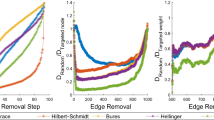Abstract
Large-scale complex systems, such as social networks, electrical power grid, database structure, consumption pattern or brain connectivity, are often modelled using network graphs. Valuable insight can be gained by measuring similarity between network graphs in order to make quantitative comparisons. Since these networks can be very large, scalability and efficiency of the algorithm are key concerns. More importantly, for graphs with unknown labelling, this graph similarity problem requires exponential time to solve using existing algorithms. In this paper, we propose a quantum walk inspired algorithm, which provides a solution to the graph similarity problem without prior knowledge on graph labelling. This algorithm is capable of distinguishing between minor structural differences, such as between strongly regular graphs with the same parameters. The algorithm has a polynomial complexity, scaling with \(O(n^9)\).







Similar content being viewed by others
References
Ek, B., VerSchneider, C., Cahill, N., Narayan, D.: A comprehensive comparison of graph theory metrics for social networks. Soc. Netw. Anal. Min. 5, 1–7 (2015)
Horváth, T., Gärtner, T., Wrobel, S.: “Cyclic pattern kernels for predictive graph mining,” In: Proceedings of the Tenth ACM SIGKDD International Conference on Knowledge Discovery and Data Mining, KDD ’04, pp. 158–167, ACM (2004)
Luo, Y., Zhao, Y., Cheng, L., Jiang, P., Wang, J.: Protein-protein Interaction Network Comparison Based on Wavelet and Principal Component Analysis, pp. 294–298. IEEE Publishing, New York (2010)
Mheich, A., Hassan, M., Khalil, M., Gripon, V., Dufor, O., Wendling, F.: Siminet: a novel method for quantifying brain network similarity. IEEE Trans. Pattern Anal. Mach. Intell. 40(9), 2238–2249 (2017)
Zheng, W., Zou, L., Lian, X., Wang, D., Zhao, D.: Efficient graph similarity search over large graph databases. IEEE Trans. Knowl. Data Eng. 27, 964–978 (2015)
Showbridge, P., Kraetzl, M., Ray, D.: Detection of Abnormal Change in Dynamic Networks, pp. 557–562. IEEE Publishing, New York (1999)
Koutra, D., Vogelstein, J.T., Faloutsos, C.: DELTACON: A principled massive-graph similarity function, arXiv:1304.4657 (2013)
Bunke, H.: Graph matching: Theoretical foundations, algorithms, and applications, In: Proceedings of Vision Interface 2000, Montreal, pp. 82–88 (2000)
Emmert-Streib, F., Dehmer, M., Shi, Y.: Fifty years of graph matching, network alignment and network comparison. J. Inf. Sci. 346–347, 180–197 (2016)
Levi, G.: A note on the derivation of maximal common subgraphs of two directed or undirected graphs. CALCOLO 9, 341–352 (1973)
Bunke, H., Shearer, K.: A graph distance metric based on the maximal common subgraph. Pattern Recogn. Lett. 19, 255–259 (1998)
Douglas, B.L., Wang, J.B.: A classical approach to the graph isomorphism problem using quantum walks. J. Phys. A: Math. Theor. 41, 075303 (2008)
Berry, S.D., Wang, J.B.: Two-particle quantum walks: Entanglement and graph isomorphism testing. Phys. Rev. A 83, 042317 (2011)
Umeyama, S.: An eigendecomposition approach to weighted graph matching problems. IEEE Trans. Pattern Anal. Mach. Intell. 10, 695–703 (1988)
Manouchehri, K., Wang, J.: Physical Implementation of Quantum Walks, Quantum Science and Technology, 1st edn. Springer, Berlin, Heidelberg (2013)
Watrous, J.: Quantum simulations of classical random walks and undirected graph connectivity. J. Comput. Syst. Sci. 62, 376–391 (2001)
Erdős, P., Rènyi, A.: On random graphs. Publ. Math. 6, 290–297 (1959)
Erdős, P., Rènyi, A.: On the evolution of random graphs, In: Publication of the Mathematical Institute of the Hungarian Academy of Sciences (1960) pp. 17–61
Ganesh, A., Massoulie, L., Towsley, D.: The Effect of Network Topology on the Spread of Epidemics, pp. 1455–1466. IEEE, New York (2005)
Barabási, A.-L., Albert, R.: Emergence of scaling in random networks. Science 286, 509–512 (1999)
Albert, H.J.R., Barabási, A.-L.: Internet: Diameter of the world-wide web. Nature 401, 130–131 (1999)
Albert, R.: Scale-free networks in cell biology. J. Cell Sci. 118, 4947–4957 (2005)
Nafis, S., Kalaiarasan, P., Brojen Singh, R.K., Husain, M., Rameshwar, N.K.: Bamezai, Apoptosis regulatory protein-protein interaction demonstrates hierarchical scale-free fractal network. Brief. Bioinform. 16, 675–699 (2015)
He, B.: Scale-free brain activity: past, present, and future. Trends In Cogn. Sci. 18, 480–487 (2014)
López-Pintado, D.: Diffusion in complex social networks. Games Econ. Behav. 62, 573–590 (2008)
Barabási, A.-L., Albert, R., Jeong, H.: Scale-free characteristics of random networks: the topology of the world-wide web. Phys. A 281, 69–77 (2000)
Bose, R.C.: Strongly regular graphs, partial geometries and partially balanced designs. Pacific J. Math. 13, 389–419 (1963)
Acknowledgements
This work was supported by resources provided by The Pawsey Supercomputing Centre with funding from the Australian Government and the Government of Western Australia. YL acknowledges funding from the National Sciences and Engineering Research Council of Canada.
Author information
Authors and Affiliations
Corresponding author
Additional information
Publisher's Note
Springer Nature remains neutral with regard to jurisdictional claims in published maps and institutional affiliations.
Rights and permissions
About this article
Cite this article
Schofield, C., Wang, J.B. & Li, Y. Quantum walk inspired algorithm for graph similarity and isomorphism. Quantum Inf Process 19, 281 (2020). https://doi.org/10.1007/s11128-020-02758-7
Received:
Accepted:
Published:
DOI: https://doi.org/10.1007/s11128-020-02758-7




